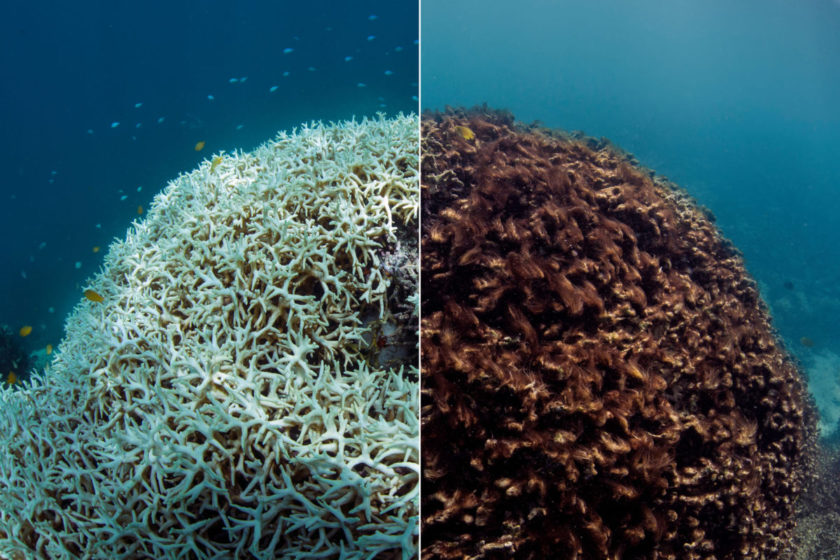
Yes, this is all about the impact of climate change upon coral reefs, or as the author of a newly published study in Nature, Professor Terry Hughes, Director of the ARC Centre of Excellence for Coral Reef Studies at James Cook University puts it, ….
“Dead corals don’t make babies,”
What does the new study establish?
The study, published on 3rd April in Nature is titled “Global warming impairs stock–recruitment dynamics of corals“.
Back in 2016 and also 2017 there were mass bleaching events that greatly impacted the Great Barrief Reef. Normally after such events, there is an expectation that it will all bounce back, so the researchers conducted a detailed analysis in 2018 to see what actually happened. They measured how many adult corals survived along the length of the world’s largest reef system following the previous extreme heat stress, and how many new corals they then produced to replenish the Great Barrier Reef. What they found is that the previous loss of adults resulted in a crash in coral replenishment compared to levels measured in previous years before mass coral bleaching.
Observations by the Study Authors
Via the Coral Reef Studies press release here …
Professor Terry Hughes, the lead author of the study …
“The number of new corals settling on the Great Barrier Reef declined by 89 percent following the unprecedented loss of adult corals from global warming in 2016 and 2017.”
Professor Andrew Baird, co-author …
“The number of coral larvae that are produced each year, and where they travel to before settling on a reef, are vital components of the resilience of the Great Barrier Reef. Our study shows that reef resilience is now severely compromised by global warming
The biggest decline in replenishment, a 93% drop compared to previous years, occurred in the dominant branching and table coral, Acropora. As adults these corals provide most of the three-dimensional coral habitat that support thousands of other species,”
The mix of baby coral species has shifted, and that in turn will affect the future mix of adults, as a slower than normal recovery unfolds over the next decade or longer”
Professor Terry Hughes added …
“The decline in coral recruitment matches the extent of mortality of the adult brood stock in different parts of the Reef, Areas that lost the most corals had the greatest declines in replenishment.
We expect coral recruitment will gradually recover over the next five to ten years, as surviving corals grow and more of them reach sexual maturity, assuming of course that we don’t see another mass bleaching event in the coming decade”
Professor Morgan Pratchett, another co-author …
“It’s highly unlikely that we could escape a fifth or sixth event in the coming decade,
We used to think that the Great Barrier Reef was too big to fail – until now,
For example, when one part was damaged by a cyclone, the surrounding reefs provided the larvae for recovery. But now, the scale of severe damage from heat extremes in 2016 and 2017 was nearly 1500km—vastly larger than a cyclone track.”
Professor Pratchett when on to explain that the southern reefs that escaped the bleaching are still in very good condition, but they are too far away to replenish reefs further north.
But Coral Reefs can Recover … right?
Given enough time, Coral Reefs do bounce back after bleaching events, so why is this now different?
As explained within the paper, climate change is the problem here …
it will take at least a decade for the fastest growing species to recover and much longer for longer- lived and slow-growing species.
… but in the context of climate change that is laid out elsewhere in the paper, that’s not going happen …
at 100 reef locations throughout the tropics, the interval between pairs of recurrent bleaching events has diminished from 25 years in the 1980s to only 5.9 years since 2010. The Great Barrier Reef has experienced mass bleaching 4 times in the past 20 years, and it is projected by climate models to bleach twice each decade from 2035, and annually after 2044
The lead author, Prof Terry Hughes, lays out the blindly obvious solution …
“There’s only one way to fix this problem, and that’s to tackle the root cause of global heating by reducing net greenhouse gas emissions to zero as quickly as possible.”
What conclusion does this lead to?
According to the most recent assessment by the Intergovernmental Panel on Climate Change, 70–90% of the world’s coral reefs could disappear by as soon as 2030 owing to global warming, unless decisive action is taken to reduce greenhouse gas emissions.
Study Data: The collapse of coral recruitment along the 2,300-km length of the Great Barrier Reef
The newly published paper contains the following illustration of the data that they gathered…

Panel A above on the left – The norm: Density of coral recruits measured over three decades, from 1996 to 2016
Panel B above in the middle – The Impact: Density of recruits after mass mortality of corals in 2016 and 2017 due to back-to-back bleaching events
Within A and B above, The area of each circle is scaled to the overall recruit density of spawners and brooders combined. Yellow and blue indicate the proportion of spawners and brooders, respectively
Panel C above on the right – Changes over time in coral cover and recruitment density on reefs (n = 15) sampled in 1996 and again in 2018
Reef Reality
The Australian Academy of Science, an independent organisation representing Australia’s leading scientists, has published the following…
Further Reading
- National Geographic (3rd April 2019) – The Great Barrier Reef’s corals are struggling to recover fast enough
- The Washington Post (3rd April 2019) – The Great Barrier Reef is being battered by climate change, and it might only get worse
- PBS (3rd April 2019) – How global warming is permanently reshaping the Great Barrier Reef
